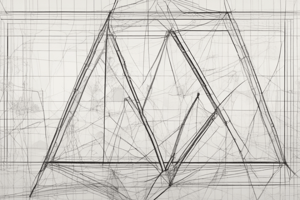Podcast
Questions and Answers
A square has a side length of 7 units. If the side length is doubled, what is the effect on the area of the square?
A square has a side length of 7 units. If the side length is doubled, what is the effect on the area of the square?
- The area remains the same.
- The area is doubled.
- The area is quadrupled. (correct)
- The area is tripled.
A rectangle has a length of 10 units and a width of 5 units. Which of the following changes would result in the greatest increase in the rectangle's area?
A rectangle has a length of 10 units and a width of 5 units. Which of the following changes would result in the greatest increase in the rectangle's area?
- Doubling the width. (correct)
- Increasing both the length and width by 1 unit.
- Increasing the width by 2 units.
- Increasing the length by 2 units.
A parallelogram has a base of 8 cm and a height of 4 cm. If the height is increased by 50% and the base is decreased by 25%, what is the new area of the parallelogram?
A parallelogram has a base of 8 cm and a height of 4 cm. If the height is increased by 50% and the base is decreased by 25%, what is the new area of the parallelogram?
- 60 $cm^2$
- 24 $cm^2$
- 12 $cm^2$
- 48 $cm^2$ (correct)
A triangle has a base of 12 inches and a height of 6 inches. If the base remains constant, what change in height would result in the area of the triangle being equal to the area of a square with a side length of 6 inches?
A triangle has a base of 12 inches and a height of 6 inches. If the base remains constant, what change in height would result in the area of the triangle being equal to the area of a square with a side length of 6 inches?
A trapezoid has bases of 6 m and 10 m, and a height of 4 m. How would the area of the trapezoid change if both bases were doubled while the height was halved?
A trapezoid has bases of 6 m and 10 m, and a height of 4 m. How would the area of the trapezoid change if both bases were doubled while the height was halved?
Flashcards
Area of a square
Area of a square
Area of a square is the side length multiplied by itself.
Area of a rectangle
Area of a rectangle
Area of a rectangle is the product of its length and width.
Area of a parallelogram
Area of a parallelogram
Area of a parallelogram is the base multiplied by the height.
Area of a triangle
Area of a triangle
Signup and view all the flashcards
Composite figure
Composite figure
Signup and view all the flashcards
Study Notes
- The below are area formulas for different shapes
Formulas
- Square: A=s²
- Rectangle: A=lw
- Parallelogram: A=bh
- Triangle: A=bh/2
- Trapezoid: A=((b₁+b₂)⋅h)/2
Composite Figure
- Can be separated into regions that are basic plane figures
Studying That Suits You
Use AI to generate personalized quizzes and flashcards to suit your learning preferences.
Related Documents
Description
Explore area formulas for squares, rectangles, parallelograms, triangles, and trapezoids. Learn how to apply these formulas to calculate the area of various shapes. Understand how composite figures can be divided into basic shapes for area calculation.




